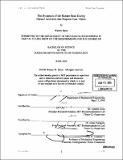The dynamics of the human head during natural activities that require clear vision
Author(s)
Bates, Warren (Warren W.)
DownloadFull printable version (2.195Mb)
Alternative title
Human head dynamics
Other Contributors
Massachusetts Institute of Technology. Dept. of Mechanical Engineering.
Advisor
Lynette Jones and James Tangorra.
Terms of use
Metadata
Show full item recordAbstract
The current understanding of the dynamics of the human head, and the demands placed on its control and stability systems, is based largely on the results of experiments conducted in artificial settings, such as when subjects are tasked with walking or running in place, and may not reflect the dynamics of the head during normal behaviors. The objective of this research was to quantify the dynamics of the head during natural activities that require clear vision and to establish input-output relations between the trunk's motion and the head's response. A portable sensor and data acquisition system was developed using MEMs based angular velocity sensors to track the yaw and pitch velocities of the head and the trunk. Subjects were tested under experimental conditions that required them to 1) simultaneously walk or run, and visually track and catch a moving ball, 2) walk or run without being given a defined visual task, and 3) stand in place and maintain eye contact with the experimenter during a conversation. During all trials, head velocities rarely exceeded 160 deg/s in pitch and 200 deg/s in yaw, and trunk velocities rarely exceeded 90 deg/s in pitch and 200 deg/s in yaw. In yaw, head and trunk velocities were greatest when subjects ran without a defined visual task. (cont.) The velocities of the head and trunk decreased considerably when subjects had to also track and catch the moving ball. This reduction was in spite of subjects running approximately 50% faster than when no visual task had been given, and likely reflects the need to stabilize the head against yaw motions to maintain clear vision. Surprisingly, the results were reversed for pitch velocities. Larger magnitude head and trunk velocities occurred in pitch when subjects ran and visually tracked the ball's trajectory than when subjects ran without the visual task. For all conditions, the frequency spectra of head and trunk velocities were dominated by power between 0.0 and 2.0 Hz, with the power spectral density dropping by more than three orders of magnitude by 10.0 Hz.
Description
Thesis (S.B.)--Massachusetts Institute of Technology, Dept. of Mechanical Engineering, 2006. Includes bibliographical references (leaf 32).
Date issued
2006Department
Massachusetts Institute of Technology. Department of Mechanical EngineeringPublisher
Massachusetts Institute of Technology
Keywords
Mechanical Engineering.